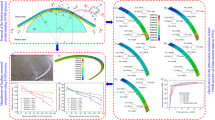Abstract
In the forming process of three-dimensional sheet metal panels of large curvature, the metal is prone for necking, fracture, wrinkling, or other defects during large plastic deformation. To achieve the specified product shapes without failure, optimum forming process was designed based on the minimum deformation path approach, and the process was implemented in a new stretch-forming process based on loading at discrete points (SF-LDP). In this paper, the minimum deformation path in a material element in SF-LDP process was summarized, and the loading trajectories for the optimum process of SF-LDP were derived and employed in the numerical simulations and experiments. The simulation results show that, compared with those of conventional-SF, the distributions of the deformations on the surface formed by SF-LDP are more uniform, the levels of strain and stress are effectively reduced, and the maximum strain is decreased by 24 % for a convex-shaped surface and 38 % for a saddle-shaped surface. Finally, experimental validation has been carried out and the results demonstrate the feasibility of the designed process.
Similar content being viewed by others
References
El-Domiaty A, Shabaik AH (1984) Bending of work-hardening metals under the influence of axial load. J Mech Work Technol 10:57–66
El-Domiaty AA, Shabar MA, Al-Ansary MD (1996) Determination of stretch-bendability of sheet metals. Int J Adv Manuf Technol 12:207–220
Parris A (1996) Precision Stretch forming for precision assembly. Ph.D. thesis, Department of Mechanical Engineering, Massachusetts Institute of Technology
Suri R, Otto K (1999) Variation modeling for a sheet stretch forming manufacturing system. CIRP Ann Manuf Technol 48:397–400
Hardt DE, Chung K, Richmond O (2001) In process control of strain in a stretch forming process. J Eng Mater Technol 123:497–503
Anagnostou EL (2002) Optimized tooling design algorithm for sheet metal forming over reconfigurable compliant tooling. Ph. D. thesis, State University of New York at Stony Brook
Papazian JM (2002) Tools of change: reconfigurable forming dies raise the efficiency of small-lot production. Mech Eng 124:52–55
Cai ZY, Wang SH, Li MZ (2008) Numerical investigation of multi-point forming process for sheet metal: wrinkling, dimpling and spring back. Int J Adv Manuf Technol 37(9–10):927–936
Cai ZY, Wang SH, Xu XD (2009) Numerical simulation for the multi-point stretch forming process of sheet metal. J Mater Process Technol 209:396–407
Wang SH, Cai ZY, Li MZ (2010) Numerical investigation of the influence of punch element in multi-point stretch forming process. Int J Adv Manuf Technol 49(5–8):475–483
Siegert K, Rennet A, Fann KJ (1997) Prediction of the final part properties in sheet metal forming by CNC-controlled stretch forming. J Mater Process Technol 71:141–146
Siegert K, Fann KJ, Rennet A (1996) CNC-controlled segmented stretch-forming process. CIRP Ann Manuf Technol 45(1):273–276
Li MZ, Han QG and Fu WZ (2011) Study of a flexible stretch forming machine. Proc. 10th Int. Techn. Plast (ICTP 2011), Aachen, Germany, 655–658
Wang Y, Li MZ (2014) Research on three-dimensional surface parts in multi-gripper flexible stretch forming. Int J Adv Manuf Technol 71:1701–1707
Cai ZY, Wang M, Yang Z (2013) Numerical investigation on the process of stretch-forming based on discretely loading for spherical sheet metal parts. Adv Mater Res 816–817:682–685
Yang Z, Cai ZY, Che CJ, Li MZ (2016) Numerical simulation research on the loading trajectory in stretch forming process based on distributed displacement loading. Int J Adv Manuf Technol 82:1352–1362
Xavier MD, de Lima NB, Plaut RL, Schön CG (2015) Strain path dependence of the FLC0 formability parameter in an interstitial free steel. Int J Adv Manuf Technol 80:1077–1085
Chung K, Richmond O (1992) Ideal forming—I. Homogeneous deformation with minimum plastic work. Int J Mech Sci 34:575–591
Chung K, Richmond O (1992) Ideal forming—II. Sheet forming with optimum deformation. Int J Mech Sci 34:617–633
Peng HL (2013) Research on process and numerical simulation of flexible clamp stretch forming. Ph. D. thesis, Jilin University (in Chinese)
Author information
Authors and Affiliations
Corresponding author
Rights and permissions
About this article
Cite this article
Cai, ZY., Yang, Z., Che, CJ. et al. Minimum deformation path sheet metal stretch-forming based on loading at discrete points. Int J Adv Manuf Technol 87, 2683–2692 (2016). https://doi.org/10.1007/s00170-016-8641-1
Received:
Accepted:
Published:
Issue Date:
DOI: https://doi.org/10.1007/s00170-016-8641-1



